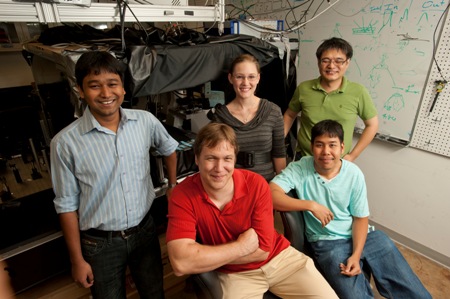A research team led by Stephan Link of Rice University Laboratory has found a method to manipulate light dispersed by gold nanorods utilizing liquid crystals. The gold nanorods capture and reemit light in a particular direction.
 Novel Method to Manipulate Light Scattered from Nanorods Using Liquid Crystals. Credit: Jeff Fitlow/Rice University
Novel Method to Manipulate Light Scattered from Nanorods Using Liquid Crystals. Credit: Jeff Fitlow/Rice University
The arrangement of liquid crystal molecules, which alternatively obstructs and exposes the light scattered from the nanoparticles, is sensitively controlled by utilizing voltage. The findings of the study were published in the Nano Letters, a journal of the American Chemical Society.
Stephan Link stated that his research team spent two years to to fine-tune the method to the point at which the light scattered from the nanoparticles can be fully controlled. He added that the basis of their method is that the liquid crystal molecules coated over each gold nanorod that functions as an optical antenna rotates in-plane. The novel device, a super half wave plate used by the research team is an upgraded version of a standard unit that modifies the light polarization, he said.
The research team believes that its novel equipment can control light transmitted from any nanostructure that includes carbon nanotubes and quantum dots. During the study, the research team put nanorods that are randomly placed on a glass slide between a series of alternating electrodes and added a cover slip and liquid crystal bath. A polyimide coating over the top cover slip directed the liquid crystals to arrange themselves in a manner parallel to the electrodes.
Controlling light from nanorods
Liquid crystals in the homogenous phase obstructed light transmitted from nanorods pointed in one direction, while allowing light from nanorods turned in another direction via a polarizer into the detector. During the application of a voltage of 4 V to the electrodes, liquid crystals near the nanorods arrange themselves with the electrical field of the electrodes, while crystals that lie above remained in the same place. The crystals’ new structure is known as a twisted nematic phase.
Link believes that his novel technique has great prospects when utilized with an arrangement of nanoparticles oriented in particular directions, where every nanoparticle can be fully controlled, like a switch.